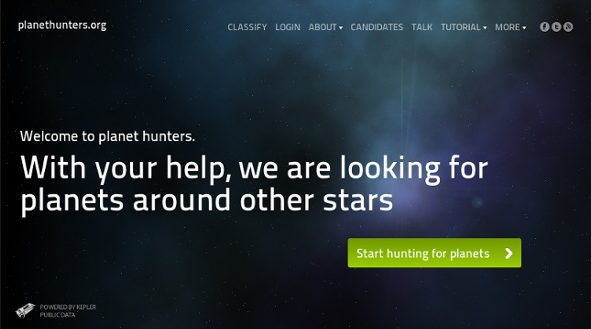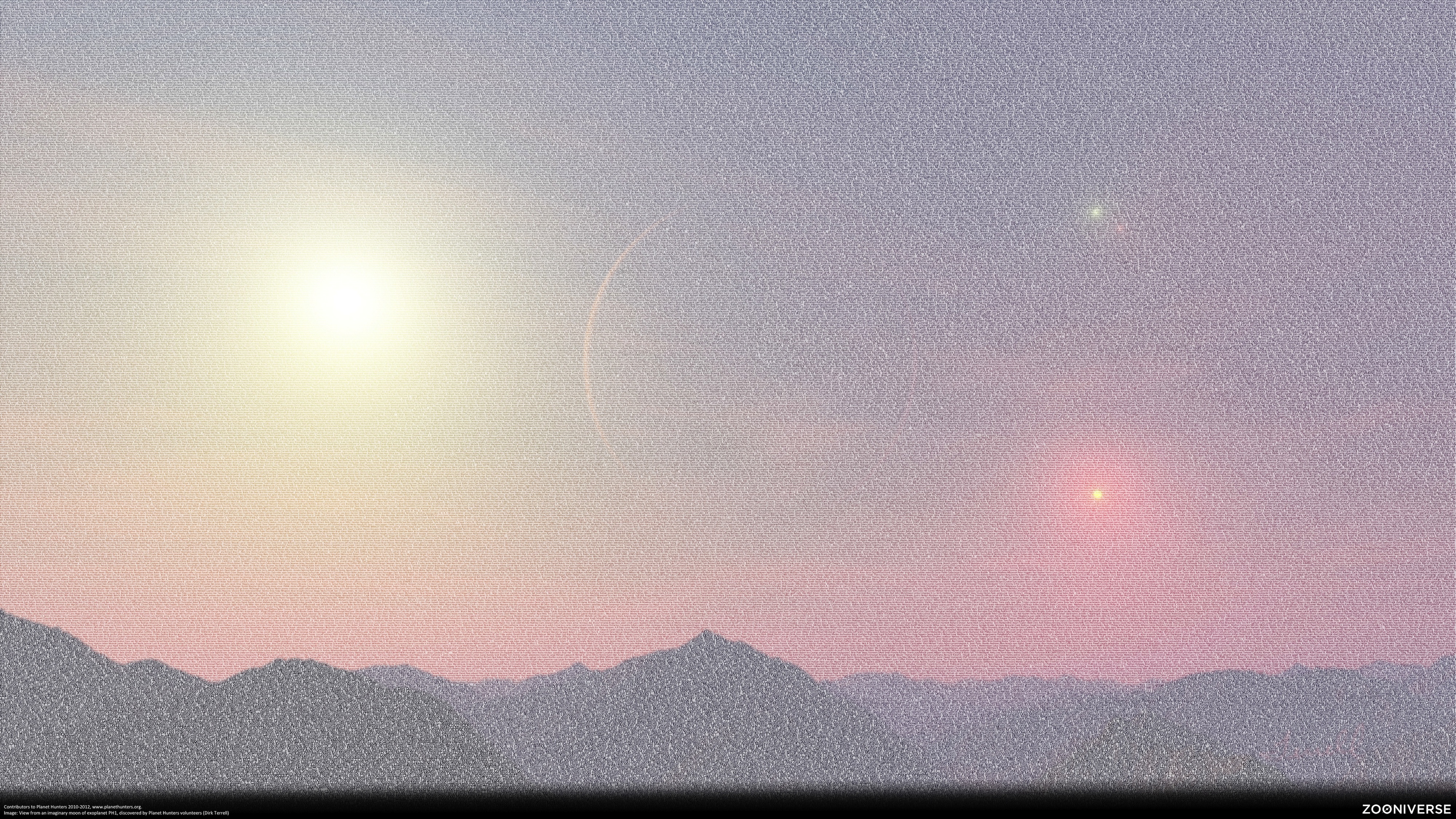It looks like you're using an Ad Blocker.
Please white-list or disable AboveTopSecret.com in your ad-blocking tool.
Thank you.
Some features of ATS will be disabled while you continue to use an ad-blocker.
4
share:
I received this today by email:

It's pretty cool that citizen scientists no different than most everyone here have helped find planets around other stars including a real-life Tatooine. PH-2 b which is part of a 4-star system! One of the most complex planets to find.
One of the cool things they did was make a poster with the names all the participants on the poster of a depiction of PH2 b. If you look at it at full size and know where to look you can even find my name lol

If you want to get involved and have any questions about what to look for or need help getting started let me know or send me a U2U.
Dear Planet Hunters,
December 16th marked Planet Hunters' 3rd Birthday. To date, nearly 280,000 people world wide had participated in the project, contributing over 20 million classifications!
2013 was been a productive year for Planet Hunters including the confirmation of PH2 b ( a Jupiter-sized planet orbiting in habitable the zone of a Sun-like star), the study of an usual dwarf novae, and the discovery of a new planet candidate in a 7 planet system. This year, 3 research papers have been accepted and published in scientific journals, with a 4th currently submitted.
Year 4 promises to be just as exciting. There is still much Kepler data, likely with unknown planets awaiting discovery, yet to be searched by the project. In addition, the Kepler mission may enter a new phase dubbed 'K2', where there will be new stars never before searched for planets. The mission is awaiting the final go ahead from NASA, but if all goes well light curves from K2 could be showing on the Planet Hunters website by the end of next year.
Last but not least, a big thank you to each and every one of you for all the time and effort you put into Planet Hunters. We couldn't do this work without all of you. Help us celebrate a new year of Planet Hunting by classifying some light curves today at www.planethunters.org...
Onward into Year 4!
~Meg and the Planet Hunters Team
PS: Don't forget you can keep up with the latest Planet Hunters news on Twitter, Facebook, and our blog.

It's pretty cool that citizen scientists no different than most everyone here have helped find planets around other stars including a real-life Tatooine. PH-2 b which is part of a 4-star system! One of the most complex planets to find.
One of the cool things they did was make a poster with the names all the participants on the poster of a depiction of PH2 b. If you look at it at full size and know where to look you can even find my name lol

If you want to get involved and have any questions about what to look for or need help getting started let me know or send me a U2U.
edit on 3-1-2014 by JadeStar because: (no reason given)
edit on 3-1-2014 by JadeStar because: (no reason
given)
edit on 3-1-2014 by JadeStar because: (no reason given)
what ? thats not fair,,,,no one ever thanxs the people that help delete them


Blowback
what ? thats not fair,,,,no one ever thanxs the people that help delete them
Having been born in 82, and schooled in an era when Pluto was the 9th planet... every time I think about Pluto getting demoted.... It's upsetting. Even if it was for the best.
IbcBen
Blowback
what ? thats not fair,,,,no one ever thanxs the people that help delete them
Having been born in 82, and schooled in an era when Pluto was the 9th planet... every time I think about Pluto getting demoted.... It's upsetting. Even if it was for the best.
As Neil DeGrasse Tyson says, "He had it coming."
It was always an odd object that didn't seem to fit the conventional planet class and it turns out it was part of a different class of object.
The cool thing is we'll be able to study it up close and personal when the New Horizons probe arrives there next year.
From their blog:

Pretty cool. And a much better way to use your brain's highly evolved pattern recognition skills than looking at rocks on Mars for animals and technology I might add.
The 2013 Astrophysics Roadmap officially titled ‘Enduring Quests Daring Visions NASA Astrophysics in the Next Three Decades’ was released on December 20th. You can read the full NASA Astrophysics Roadmap here.
Planet Hunters and Galaxy Zoo were highlighted and praised in the Roadmap. In Chapter 5 – Public Engagement: Connecting Through Astronomy:
Similarly, accessibility to NASA data via online archives has given the public an opportunity to actively participate in data analysis alongside professional astronomers. This new field of citizen science exists in many disciplines, but astrophysics is uniquely poised to build on the public’s inherent fascination with astronomy and to engage people in authentic experiences with NASA-unique data.
Projects like Galaxy Zoo and Planet Hunters (with over 855,000 registered users in Zooniverse as of this writing; see Chapters 2 and 3) have led the way in astrophysics citizen science, providing online user-friendly interfaces through which anyone can classify galaxies or look for signatures of planets in actual data. Similarly, programs such as the NASA/IPAC Teacher Archive Research Program have provided ways for educators to become involved in ongoing astronomy research using NASA data archives. Future programs should build on the community’s best-practices in order to make more NASA data accessible to the public and teachers in this highly participatory way
In addition to the mention in the Public Engagement Chapter, Panet Hunters got a cutout figure highlighting the project (shown below) in the exoplanets chapter (Chapter 2: Are We Alone?).

Pretty cool. And a much better way to use your brain's highly evolved pattern recognition skills than looking at rocks on Mars for animals and technology I might add.
edit on 4-1-2014 by JadeStar because: (no reason given)
new topics
-
Pelosi injured in Luxembourg
Other Current Events: 28 minutes ago -
Nov 2024 - Former President Barack Hussein Obama Has Lost His Aura.
US Political Madness: 2 hours ago -
Something better
Dissecting Disinformation: 7 hours ago -
The Witcher IV — Cinematic Reveal Trailer | The Game Awards 2024
Video Games: 9 hours ago -
Friday thoughts
General Chit Chat: 10 hours ago -
More Ons?
Political Conspiracies: 10 hours ago -
Canada Post strike ended by the Government of Canada
Mainstream News: 10 hours ago
top topics
-
They Know
Aliens and UFOs: 15 hours ago, 18 flags -
Something better
Dissecting Disinformation: 7 hours ago, 8 flags -
More Ons?
Political Conspiracies: 10 hours ago, 6 flags -
Friday thoughts
General Chit Chat: 10 hours ago, 5 flags -
Nov 2024 - Former President Barack Hussein Obama Has Lost His Aura.
US Political Madness: 2 hours ago, 5 flags -
Canada Post strike ended by the Government of Canada
Mainstream News: 10 hours ago, 4 flags -
The Witcher IV — Cinematic Reveal Trailer | The Game Awards 2024
Video Games: 9 hours ago, 3 flags -
Pelosi injured in Luxembourg
Other Current Events: 28 minutes ago, 2 flags -
Drones (QUESTION) TERMINATOR (QUESTION)
General Chit Chat: 16 hours ago, 1 flags
4
